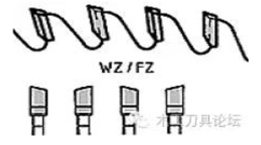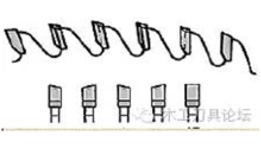FAQ
1. The cutting resistance of the tool can be evenly transmitted to the tool holder through the shim, and the cutting resistance under the tool head will not be deformed due to excessive cutting resistance.
2. It plays a role of chip breaking during cutting, and the chips will not directly block the insert row and thus protect the insert row, otherwise the bottom of the insert will be hollowed out by the chips
1. Timber longitudinal saw or two-piece combined scoring saw

2. Main saw blades for wood cross-cut saws, blockboards, plywood and wood-based panels, and main saw blades for electronic cutting saws.

3. Smashing knife saw blade, edge band cutting saw blade

4. Wood cross section, aluminum alloy and plastic profile

5. Timber cross-saw, main saw blade for veneer wood-based panel

6. Timber longitudinal saw, mostly used for circular saw blades for thin roads

7. It is used on the main saw blade of electronic cutting saw, the main saw blade of wood-based panels or veneer wood-based panels, and can also cut plastics and non-ferrous metals.

8. Scribing saw used for electronic billing.

9. Scribing saw for electronic cutting saws, sawing PVC veneer or easy-to-chip veneer.

10. Wood longitudinal, transverse sawing or plywood, blockboard processing.

11. Used on sawing machines without scoring saws, such as vertical electronic cutting saws, the front angle is 60 degrees.

12. Used on sliding table saws without scoring saws, the front angle is greater than 0 degrees.

13. Used on sawing machines without a scoring saw

14. It is used on the main saw blade of the electronic cutting saw or the scribing saw after forming, and the cutting quality can meet the requirements of direct edge banding.

Operation guide of solid saw cutter:
1. The operator should use necessary safety shields to avoid accidents.
2. Check the saw cutter before use. If the cutter is deformed, cracked or other safety factor is detected, immediately stop using. Saw cutter can only be used only after being checked and confirmed by professionals. Please use a clean and sharp saw cutter.
3. The cutter must be installed and used in strict accordance with the operating instructions and the safe use rules. It must be installed firmly before cutting. Do not beat or hit the cutter during installation.
4. Carbide saw cutters can only be used on matching equipment, cannot be used to cut sandy materials such as cement, unless otherwise specified.
5. Do not cut when the cutter has not reached the normal speed. The maximum speed must be observed and must not be exceeded.
6. All irrelevant items must be cleared before operating the equipment. Only the operator is allowed in the working area. The cutter cannot touch any other tools, installation tools or equipment parts during operation, and all unsafe factors should be eliminated. .
7. The equipment cannot be unattended during operation.
8. Before cutting, check the workpieces carefully to ensure that there are no impurities in the workpieces.
First of all, cemented carbide has extremely high hardness and wear resistance. At room temperature, its hardness can reach 69 to 81HRC, and its wear resistance is also quite good. Therefore, the cutting speed of the tool made of this material can be 4 to 7 times faster than that of the high-speed steel tool, and the service life will not be lower than the latter, but it is 5 to 80 times longer than the high-speed steel tool, and can be used for cutting high hardness materials with hardness up to 50HRC.
Secondly, cemented carbide also has high strength and elastic modulus. Its compressive strength reaches 6000MPa, and its elastic modulus can reach up to 735MPa. Both indexes are higher than high-speed steel materials. However, the bending strength of cemented carbide is low, only 1000 to 3000 MPa.
Third, cemented carbide has good corrosion resistance, oxidation resistance and high temperature resistance. Tools made of cemented carbide are generally able to resist corrosion caused by the atmosphere, acids, alkalis, etc., are not prone to oxidation, and can remain hard at a high temperature of 900 to 1000 degrees.
Fourth, the linear expansion coefficient of cemented carbide is very small, which leads to its stable shape and size during processing.
PCBN: Polycrystalline Cubic Boron Nitride (PCBN) is a new artificially synthesized superhard cutting tool material after synthetic diamond. Its hardness is second only to diamond and is the most suitable cutting tool material for high-speed cutting of ferrous metals, such as hardened steel, chilled cast iron and surface thermal spraying materials. When cutting medium-low hardness materials, it often does not show good cutting performance, the tool life is even shorter than cemented carbide. When cutting workpieces with hardness above 50HRA, the tool begins to exert its super-hard performance. For example, when machining workpieces with a hardness of about 60HRC, the life is over 10 times longer than that of carbide tools. Therefore, only when PCBN tools are used to process high-hardness materials can they exert their superior performance.
PCD: Polycrystalline diamond. The application of PCD tools has expanded from traditional metal cutting to stone cutting, wood cutting , metal matrix composites, glass, engineering ceramics and other materials. PCD tools are mainly used in the following two aspects: ①non-ferrous metal materials that are difficult to cut: When ordinary tools are used to cut difficult-to-cut non-ferrous materials, the tools tend to be easily worn and the cutting efficiency is low. PCD tools can show good cutting performance. For example, PCD tools can be used to effectively cut a new type of engine piston material-hypereutectic silicon aluminum alloy (a breakthrough has been made in the research on the processing mechanism of this material). ②difficult-to-cut non-metallic materials: PCD tools are very suitable for the cutting of difficult-to-cut non-metallic materials such as stone, hard carbon, carbon fiber reinforced plastic (CFRP), and man-made plates.
1. carboneto de tungstênio é caracterizado por alta dureza
A dureza do carboneto pode ser quase tão dura quanto o diamante e mais dura do que o aço ferramenta. Alta dureza, resulta em maior resistência ao desgaste em aplicações abrasivas. As peças de desgaste de carboneto duram mais.
2. carboneto de tungstênio tem alta resistência ao impacto
Impactos repetidos de alta energia podem fazer com que as peças de aço se deteriorem mais rapidamente. O carboneto tem alta resistência ao impacto e pode resistir ao desgaste e às aplicações de impacto por muito mais tempo do que a cerâmica ou o aço. Isso resulta em menos reparos e peças de reposição e menor custo operacional.
3. carboneto de tungstênio tem excelentes efeitos de corrosão.
Certos graus de carboneto têm aglutinantes especiais com níquel e cromo para aumentar a resistência à corrosão. Os graus de carboneto podem ter resistência à corrosão para lidar com ambientes com acetona, etanol, gasolina, amônia, a maioria das bases, ácidos fracos, água da torneira e outros solventes orgânicos.
4. carboneto de tungstênio pode resistir a altas temperaturas
O carboneto pode ter um desempenho confiável em temperaturas onde outros materiais começariam a amolecer. À medida que o aço aquece, ele começa a recozer e perder dureza, diminuindo assim a resistência ao desgaste. O tungstênio não recoze e pode ser usado em ambientes com temperaturas próximas de 1000 F.
5. carboneto de tungstênio é resistente ao desgaste
As peças de aço que sofrem abrasão extrema não duram tanto quanto as peças de desgaste de metal duro. Na maioria dos casos, o carboneto durará mais do que o aço típico por um fator de 25 a 1 ou mais!